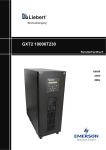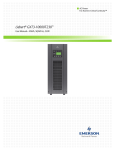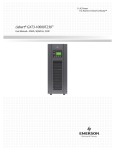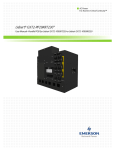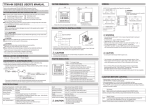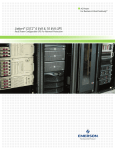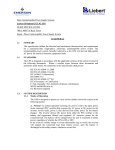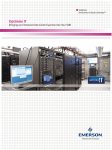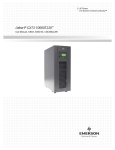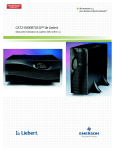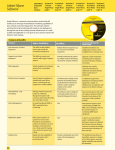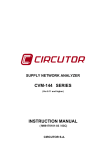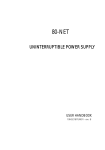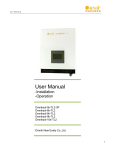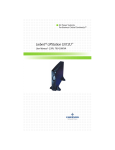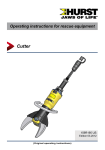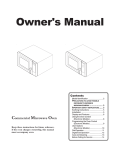Download GXT2 10000T230
Transcript
Power Availability GXT2 10000T230 User Manual 10kVA 230V 50/60Hz Table Of Contents Important Safety Instructions ...................................................................... 1 1 Introduction and System Description ........................................................ 5 1.1 Device Overview..............................................................................................................6 2 Unpacking the UPS and Site Preparation ................................................. 7 2.1 Inspection .........................................................................................................................7 2.2 Required Setup Equipment...............................................................................................7 2.3 Unpacking ........................................................................................................................7 2.4 Storage..............................................................................................................................8 2.5 Handling ...........................................................................................................................8 2.6 Environmental Conditions................................................................................................8 2.7 Access required ................................................................................................................8 2.8 Floor/Rack Loading..........................................................................................................8 2.9 Inventory List ...................................................................................................................9 2.10 Clearance........................................................................................................................9 2.11 Repacking the UPS.........................................................................................................9 3 Installation.................................................................................................. 11 3.1 Electrical preparations....................................................................................................11 3.2 Installation Data .............................................................................................................12 3.3 Current Table and Suggested Cable Sizes......................................................................16 3.4 Neutral Connection ........................................................................................................17 3.5 External Protection and Isolating Devices .....................................................................17 3.6 Installation of Differential Protection Devices...............................................................18 3.7 External Electrical Connections .....................................................................................18 3.8 Connecting Mains and Load ..........................................................................................19 3.9 Terminal Blocks for UPS ...............................................................................................19 3.10 Connecting Power Cables ............................................................................................19 3.11 External Tower Batteries..............................................................................................20 3.12 Connecting an External Battery Extension ..................................................................20 3.13 Battery Precautions ......................................................................................................21 3.14 Configuration Program................................................................................................22 3.14.1 GXT2-10000T230 Configuration Program Features ......................................22 3.14.2 What You Will Need ......................................................................................22 4 Operation.................................................................................................... 23 4.1 Normal Operating...........................................................................................................23 4.1.1 Block diagram ...................................................................................................23 4.2 Control Panel..................................................................................................................24 4.2.1 Controls and Messages .....................................................................................24 4.2.2 Setup Parameter 53 of LCD Main Menu ..........................................................29 4.2.3 Warning Indicators ...........................................................................................29 4.2.4 Fault Indicators .................................................................................................29 4.3 Pre-startup ......................................................................................................................31 4.4 UPS Startup Procedure - Single Block...........................................................................32 4.5 UPS Shutdown Procedure - All Ratings ........................................................................33 4.6 Maintenance Bypass Procedure .....................................................................................33 4.7 Return from Maintenance Bypass Procedure.................................................................34 4.8 Maintenance Switch, Off position..................................................................................34 4.9 Functional Test...............................................................................................................35 4.10 Emergency Switch Device ...........................................................................................35 4.11 Remote Emergency Power Off ...................................................................................36 4.12 Self-Tests......................................................................................................................37 4.12.1 Lamp Test .......................................................................................................37 4.12.2 Battery Test .....................................................................................................37 5 Maintenance ............................................................................................... 39 5.1 Testing, replacement and disposal of batteries...............................................................39 5.1.1 Easy Battery Replacement ................................................................................39 5.2 Storage............................................................................................................................40 5.3 Cleaning .........................................................................................................................40 6 Interfaces .................................................................................................... 41 6.1 Communications Interface Port......................................................................................41 6.2 Relay Contacts................................................................................................................41 6.2.1 Pin 11 - Remote Shutdown on Battery .............................................................43 6.2.2 Pin 16 - Any Mode Shutdown ..........................................................................43 6.3 UPS Intelligent Communications...................................................................................44 7 Troubleshooting ......................................................................................... 45 8 Options........................................................................................................ 47 8.1 External Battery Cabinets...............................................................................................47 8.2 Additional Battery Charger ............................................................................................47 8.3 Optional Interfaces .........................................................................................................48 8.4 Battery Run Times .........................................................................................................48 9 Product Warranty Registration ............................................................... 49 Important Safety Instructions WARNING ! Opening or removing the cover may expose you to lethal voltages within this unit even when it is apparently not operating and the input wiring is disconnected from the electrical source. Observe all cautions and warnings in this manual. Failure to do so may result in serious injury or death. Refer all UPS and battery service to qualified service personnel. Do not attempt to service this product yourself. Never work alone. This manual contains important safety instructions that must be followed when installing, operating and maintaining the GXT2-10000T230 uninterruptible power system (UPS). Read all safety, installation and operating instructions before installing or operating the UPS. Adhere to all warnings on the unit and in this manual. Follow all operating and user instructions. The GXT2-10000T230 is not intended for use with life support or other designated critical devices. The UPS is designed for data processing equipment. If uncertain the intended use for this UPS, consult your dealer or Liebert representative. This device serves as an uninterruptible power supply for connected loads. Maximum load must not exceed that shown on the UPS rating label. The device is in compliance with all relevant safety regulations concerning information technology equipment, including electronic machines for use in an office environment. Depending on the type and rating of UPS device, certain configurations of battery extensions may be connected. These battery extensions may be connected only to the compatible basic UPS unit... WARNING ! Liebert considers the safety of personnel to be of paramount importance. For this reason it is essential that procedures relating to safety be studied before commencing work and properly adhered to thereafter. • The user or operator may intervene in the operation of the UPS provided that the instructions laid out in “Notes Regarding the EU Declaration of Conformity” on page 3 are strictly adhered to. • The installation of the UPS, described in “Installation” on page 11, may only be carried out by qualified technical personnel. • Even when all switches and interrupters are open, hazardous voltages are present within the UPS; any operation that requires protective panels to be opened or removed may be carried out by Liebert authorized technical personnel only. 1 Important Safety Instructions KEEP THESE INSTRUCTIONS IN A SAFE PLACE CAUTION ! Important Safety Instructions 2 Carefully read the following safety notices! Failure to observe the instructions may endanger your life, your health, the reliability of your device and the security of your data. • Transport the unit only in suitable packaging (protected against jolts and shocks). • If the equipment is moved from a cold environment to the operating room, condensation may occur. Before you switch on the equipment, it must be absolutely dry. An acclimatization period of at least two hours is required. • The equipment must be installed in accordance with the environmental conditions specified in “Environmental Conditions” on page 8 and in “Environmental Data” on page 12. • The UPS should not be supplied with > IT (Impedance a Terre) electrical power systems (IEC 364-ELECTRICAL INSTALLATION OF BUILDINGS). • Even with all switches in the “OFF” position(see “Control Panel” on page 24) the UPS is not isolated from the mains. To isolate completely from the mains, the power cables must be disconnected. • In case of interruption of the mains voltage, the integrated battery maintains the power supply to the user equipment. • Lay all cables so that nobody can stand on them or trip over them. When connecting the UPS to the power supply, follow the instructions in “Unpacking the UPS and Site Preparation” on page 7. • Make sure that no objects (e.g., pins, necklaces, paper clips, etc.) get inside the device. • In emergencies (e.g., damaged case, controls or power cables, penetration of liquids or foreign matter), switch off the device and contact the appropriate customer service representative. • Do not connect equipment that will overload the UPS (e.g., laser printers or vacuum cleaners) or demand DC-current (e.g., half-wave rectifiers). • When cleaning the unit, follow the instructions in “Maintenance” on page 39. • The sum of the leakage currents (protective conductor current) of the UPS and the connected devices exceeds 3.5 mA for all ratings of the UPS. Earth connection is essential before connecting supply. • Data transmission lines should not be connected or disconnected during a thunderstorm. • Remote Emergency Power Off (REPO) input is located on the rear of the unit (see “Emergency Switch Device” on page 35 and “Terminal Blocks for UPS” on page 19). When this connection is open, the logic circuit will immediately shut down the UPS output. • An Emergency Switching Device (E.S.D.) must be fitted downstream of the UPS for the wiring installation safety to comply with the European Harmonized Document HD384-4-46 S1. ! • Maintenance bypass switch is for the use of service personnel only. It is located under the rear cover. Open the safety cover to operate the maintenance bypass switch. • The Tower UPS may be connected either to 3-phase mains or single-phase mains. Therefore the right input terminals have to be connected (see “Connecting Mains and Load” on page 19). The UPS autosensing mode ensures that it adapts to the connected mains supply. Important Safety Instructions Further safety notes for GXT2-10000T230 • Do not connect more than four GXT2-240TBATTCE battery extensions to the GXT2-10000T230. This also applies when the additional battery charger is connected. • The vents for air intake and outlet at the front and rear side must not be obstructed. • The sum of the leakage currents (protective conductor current) of the UPS and the connected devices exceeds 3.5 mA. Earth connection of the unit is essential before connecting supply. CAUTION ! The supply to the load may be interrupted by opening all the switches or by turning the Maintenance Switch on the rear of the UPS to the Off position. DO NOT USE WATER to extinguish any fires that may occur in the area where the UPS is installed. Leakage currents CAUTION ! Connect the protection earth (PE) safety conductor before connecting any other cables. Radio Interference The GXT2-10000T230 is a Radio Interference Class A Product. The UPS device may cause radio interference. Do not place it near devices that are particularly susceptible to electromagnetic interference (e.g., transmitters, receivers, radar, metal detectors and antitheft devices). WARNING ! This is a product for restricted sales distribution to informed partners. Installation restrictions or additional measures may be needed to prevent radio interference. Notes Regarding the EU Declaration of Conformity The GXT2-10000T230 conforms to the following European directives: 3 73/23/EEC Directive of the council for adaptation of the legal regulations of the member states regarding electrical equipment for use within specific voltage limits, modified by directive 93/68/EEC. 89/336/EEC Directive of the council for adaptation of the legal regulations of the member states regarding electromagnetic compatibility, modified by directive 91/263/ EEC. Conformity is established through compliance with the following standards: EN 62040-1-1 EN 62040-2 Important Safety Instructions Additional information regarding adherence to these directives is included in the appendices NSR and EMC of the EU Declaration of Conformity. If required, the EU Declaration of Conformity may be requested from Liebert. 4 1 Introduction and System Description Congratulations on your purchase of the Liebert UPStation GXT2-10000T230. This system provides conditioned power to microcomputers and other sensitive electronic equipment. The UPStation GXT2-10000T230 is a compact, on-line UPS. An on-line UPS continuously conditions and regulates its output voltage whether utility power is present or not. It supplies connected equipment with clean sinewave power. Sensitive electronic equipment operates best from sinewave power. For ease of use, the UPStation GXT2-10000T230 features an LCD display for comprehensive user indications and programmable controls. It also provides self-diagnostic tests. The UPStation GXT2-10000T230 has an interface port for communication between the UPS and a network server or other computer system. This port provides detailed operating information including voltages, currents and alarm status to the host system when used in conjunction with Liebert’s MultiLinkTM software. ! Figure 1-1 CAUTION This UPS may only be operated by qualified personnel. UPStation GXT2-10000T230 control panel Liebert UPStati o n GXT ESC BYPASS FAULT UPS ON BATTERY 5 Introduction and System Description Upon generation, AC power is clean and stable. However, during transmission and distribution it is subject to voltage sags, spikes and complete power failure that may interrupt computer operations, cause data loss and damage equipment. The UPStation GXT2-10000T230 protects equipment from these disturbances. 1.1 Device Overview The GXT2-10000T230 is available at various nominal power ratings. The following table provides an overview of the various versions of the device: Table 1-1 Overview of UPS devices and batteries Type UPS with integrated battery Battery cabinet Figure 1-2 Model # GXT2-10000T230 GXT2-240TBATTCE GXT2-10000T230 front and rear views Introduction and System Description 1.Control panel 2.Liquid Crystal Display 3.Ventilation Louvers 4.Control keys Liebert UPSta ti on GXT 1 2 Liebert UPSt at i on GXT ESC 4 Nominal power 10000 VA / 7000 W 240 VDC BYPASS FAULT UPS ON BATTERY 3 5 6 7 5. Intellislot port (covered) 6. REPO contacts 7. Communications port 1 8. Parallel port (Reserved for future use) 9. Maintenance Bypass Switch (behind cover) 10.Bypass source input circuit breaker 11.Input breaker for three phase source 12.Removable sheet panel (2nd charger board can be inserted here) 13.Hardwire input and output connector terminal block 14.External battery connector 15.Cooling fans 16.Relay Contacts 6 Device Overview 8 16 15 ON ON OFF OFF ON OFF ON OFF OFF M3 OFF OFF 60A OFF 30A 30A 9 10 11 0 Bypass Source Input Breaker Input Breaker for Three Phase Source 60A/250V 60A/30A/30A/250V OPTIONAL EXT BATTERY 240V 40A 14 13 Main 1 Input~ L1 L2 L3 Main 2 Input~ N N Ouput~ L N S 12 2 Unpacking the UPS and Site Preparation 2.1 Inspection 2.2 Required Setup Equipment The following tools are required to set up your UPS: • pallet jack • utility knife or scissors • star head screwdriver 2.3 Unpacking Take care when removing the packaging to avoid damaging the UPS. Check all packaging to ensure that no items are accidentally discarded. Remove the packaging in the sequence shown below. Figure 2-1 Unpacking Inspection 7 Unpacking the UPS and Site Preparation Upon receiving your GXT2-10000T230, examine the packaging for any signs of mishandling or damage. While removing the packaging materials, inspect the UPS for damage. If any damage is noted, notify your local Liebert representative and carrier. Any damage or missing parts must be reported to the supplier within eight days of delivery. 2.4 Storage If the UPS will not be installed immediately, store the unit indoors in a clean and dry area. Protect all the equipment, including its batteries, from extreme temperature, high humidity, spills and other damaging conditions. Refer to the table below for permissible storage environmental conditions. Table 2-1 Storage conditions Unpacking the UPS and Site Preparation Temperature limits Batteries ONLY 0oC to +40oC (32-104oF) Temperature limits UPS without batteries -25oC to +55oC (-13oF to +131oF) from 0% to 90%, NONCONDENSING Relative humidity 2.5 Handling The equipment must be kept upright at all times and handled with care. It may be damaged if dropped or subjected to severe impact. 2.6 Environmental Conditions The GXT2-10000T230 must be installed vertically, on a level and even surface and in an area protected from extreme temperatures, water, humidity and the presence of conductive powder or dust (see “Environmental Data” on page 12). Do not stack units; do not place any objects on top of a unit. • The functional temperature range of the UPS is 0oC to 40oC (32-104oF) • The ideal ambient temperature range is 15oC to 25oC (59-77oF) • The battery life is defined at 20oC. Each increment of 10oC above 25oC (increment of 18oF above 77oF) reduces the expected life by 50%. 2.7 Access required The area must have sufficient space for installation procedures and for routine maintenance. Access doors must be sufficiently large to permit passage of the UPS. 2.8 Floor/Rack Loading Ensure that the floor where the UPS/batteries will be installed will support the unit’s weight (see Table 3-2 for the unit’s weight). 8 Storage 2.9 Inventory List 2.10 Clearance The UPS is fitted with wheels for ease of movement over short distances. You must leave 300 centimeters around the side and rear of the unit to allow a flow of air and to provide access for any routine maintenance that may involve removal of the panels. Figure 2-2 Clearance 2.11 Repacking the UPS To repack the UPS, proceed as follows: 1. Do not pack the equipment until at least six hours have elapsed since the last recharge. 2. Make sure to re-use the original packing material to ship the UPS. Inventory List 9 Unpacking the UPS and Site Preparation • The GXT2-10000T230 comes with the following: - one jumper for common feeding (connect mains and reserve) - user manual - multi-link CD - Configuration program CD - RS232 cable - Four rubber bumpers to be used if adding a GXT2-240TVBATT next to the UPS. 3 Installation 3.1 Electrical preparations Before you begin installation, the input source must be isolated and secured to prevent reconnection during installation. The input circuit breaker on the rear of the UPS must be in the Off position. Warning ! • Installation may be carried out only by qualified technicians, conforming to applicable safety standards. • Electric shock hazard: Even when the unit is disconnected from the mains, hazadous voltage may still be supplied by the battery. Both poles should be disconnected before carrying out maintenance work inside the UPS. Installation For electrical installation, the nominal current rating of the source must be observed. The UPS is not suitable for connection to 16A subdistribution systems. Electrical preparations 11 3.2 Installation Data Table 3-1 Environmental Data 0oC to +40oC (32-104oF) Ambient Temperature Relative Humidity (w/o Condensing at 20oC) Max. Altitude (w/o derating) Cable inlet Air inlet Air outlet Table 3-2 90% 1000 m a.s.l. bottom of rear side at the front and right sides at the rear Technical Data Specification Value Rectifier GXT2-10000T230 230VAC Single Phase (L, N, G) Nominal input voltage (VAC) Installation 230/400 Three Phase (L1, L2, L3, N, G) Single phase or three phase, automatic detection 176-276V for 1X1 Input phases (VAC) Input voltage 304-478V for 3X1 50/60 Auto selection Output frequency equals input frequency. When the input is nominal 50 or 60Hz ± 5%. Beyond ± 5% range, inverter free runs at nominal frequency. Nominal frequency (Hz) Frequency tolerance Maximum input power (Nominal Input Voltage, R Full Load) Float(kVA)1 8.0 Recharge (kVA)2 Power factor (at nominal V, with R full load) Input current distortion (with R full load) THDi3 8.3 Inrush current (A) (typical) 60A Single Phase Input: 0.97 Three Phase Input: 0.95 Single Phase Input: < 5% Three Phase Input: < 31% Battery charger Battery nominal voltage (V DC) 240 Battery charger input voltage range 100-276 (V AC) Output voltage (V) Multi stage charging method. 12 Installation Data Table 3-2 Technical Data Charging time to 90% capacity in inverter mode (hr.) 5 Charger output current (ADCaver) (Amps) Standard: 1.2A (1 Charger Board with Internal Batteries) Option: 4.0A (internal option) Inverter Load peak factor without derating (lpk/lrms) 10 7 0.7 105 - 125% 126 - 150% 150 - 300 (± 50)% 160 A peak Installation Nominal power rating @ 40°C (kVA) Nominal active power rating (kW) Power factor Overload • for 1 minute (%) • for 10 seconds (%) • for approximately 2 secs (RCD load) then transfer to bypass and and an audible alarm Short circuit current for 5 cycles (typical) Output voltage rating (Vac) Output frequency (Hz) Voltage regulation over input voltage and battery voltage range with load between 0% and 100% of rating Output frequency stability with mains synchronism (%) Stability with internal quartz oscillator (%) Frequency Variation Rate (Hz/sec) Output Voltage Distortion THD-V (%) 220, 230, 240 50/60, auto selection ± 2% ± 5% < 0.05% <1 Full Resistive Load < 3% Full RCD Load < 8% ≤3 Static switch Nominal frequency (Hz) Frequency tolerance (%) Voltage tolerance (V) Out-of-phase switching time (ms) in case of inverter fault and bypass is out if tolerance 50 / 60 auto selection Same as Input, ± 5% 176 - 255 No transfer Overload Over load > 100% Audible alarm Installation Data 13 Table 3-2 Technical Data In-phase switching time - direct/ conditioned (ms)4 Installation condition/direct (ms) UPS data 25% of load (%) 50% of load (%) 75% of load (%) 100% of load (%) Maximum noise level at 1 meter front-side (dBA) normal mode and battery mode Degree of protection Dimensions Height (mm) Width (mm) Depth (mm) Color Weight with integrated batteries (kg) 0.5 0.5 87 91 92 92 ≤ 50 IP20 800 300 675 Black 110 Battery Optimum battery temperature (°C)5 Power output (kW) Recommended no. of cells End of discharge (VDC) Battery type Battery number Discharging time (minutes) Auto battery missing detection Ext. Battery Cabinet: Battery type Battery number (pcs.) Height (mm) Width (mm) Depth (mm) Color Weight with integrated batteries (kg) 14 Installation Data 15 - 25 8.5 120 200 YUASA: REW 45-12 (12V / 45W / 9Ah) 20 5 Yes 1Set / 2Set YUASA NP7-12 12V7AH 40 / 80 800 300 675 Black 162 Table 3-2 Technical Data Performance EN 62040-3 Dynamic characteristics Step load response Load 0% to 100% to 0% Load 20% to 100% to 20% VFI - S S - 1 1 1 +/- 5% maximum, returns to static regulation within 200 ms. +/- 3% maximum, returns to static regulation within 200 ms. Startup Operation 1 Maximum input power (normal V, R full load) float (kVA) = [Pout (KW)/efficiency] / input_power_factor Example for the 10kVA float (kVA) = (7,0/0,91)/0,95 = 8100VA 2 Recharge (kVA) = [(Pout (KW)/efficiency)+Pbattchargerinput]/input_power_factor Example for the 10kVA Pbattchargerinput = (2.5*268)/efficiency=(2.5*268)/0,9=744W recharge (kVA) = [(7,0 (KW)/0,91)+744]/0,95 = 8880VA 3 THDi measure method is applied to EN61000-3-2, 1995 4 In-phase switching time direct / conditioned means time line (bypass) transferring to inverter 5 The expected battery life is defined at 20°C. For every increment of 10°C, above 20°C, the expected life is halved Installation Data 15 Installation Input AC < 100VAC or greater than UPS will not start 280 VAC Input >176 or less than 276 UPS start enabled +/- 5% maximum, returns to static reguLoad 0% to 100% to 0% lation within 200 ms. 3.3 Current Table and Suggested Cable Sizes The following table indicates the currents and recommended sizes of the connecting cables in accordance with regulations IEC-287 and DIN VDE 0298 1. PVC-insulated copper cables (@ 70oC) (158oF). 2. Air temperature surrounding the conduits should not be greater than 30oC (86oF). NOTE Should there be any variation in the conditions, it will be necessary to verify whether the cable dimensions satisfy the requirements of IEC287 and DIN VDE 0298. In cases where the cables are so long that they cause a drop in voltage of >3%, a larger size must be used. Table 3-3 Connection data Description Installation Connector size Max input current Input cable size (and neutral) Max output current Output cable size (and neutral) Earth cable size Unit UPS power rating kVA 10 - 1/1 10 - 3/1 mm2 Arms 10 10 56 56 mm2 10 10 Arms 56 56 mm2 10 10 mm2 10 10 When the UPS is in Bypass mode, the entire output current of the UPS is passed through the phase L1 and Neutral cables. To simplify connection data, no distinction has been made between phase L1 and phases L2 and L3. The cable sizes are defined for the maximum current carried by the output cables. WARNING ! Particularly sensitive equipment may be susceptible to interference. To prevent this, Liebert suggests: • Mains input, output and external battery cables to the UPS in earthed, metal conduits, or • Use shielded cables Routing of cables (e.g. power supplies, communication or data lines) to other equipment, should be kept separate from that of UPS cables. 16 Current Table and Suggested Cable Sizes 3.4 Neutral Connection The installation of the UPS does not affect the existing Neutral system. The Neutral system may be affected if the UPS is operating with the Neutral switched upstream. 3.5 External Protection and Isolating Devices External devices for the protection of cables and for isolating the UPS external to the UPS must be installed upstream of the equipment. Select and configure the isolating device according to the table below. • Such devices must be either curve C automatic circuit breakers or type GL/ GG fuses. • Disconnecting devices must be provided in building installations and other locations. WARNING The following label must be displayed on all switching devices installed in the same electrical system as the UPS, even when they are located at a distance from the area. ENSURE THAT THE UNINTERRUPTIBLE POWER SYSTEM IS ISOLATED BEFORE WORKING ON THIS CIRCUIT. Table 3-4 Input Fuse Breaker Tower power rating (phases in/out) 10 - (1/1) 10 - (3/1) 63 Amps 63 Amps 63 Amps 63 Amps Output Fuse Breaker 63 Amps 63 Amps Protection Description 63 Amps 63 Amps This table indicates the protection devices (circuit breakers and fuses) that must be installed for the protection of both the cables and the equipment. NOTE If an external battery cabinet is present it should be located next to the UPS unit. • When such an option is supplied by Liebert it comes complete with protection devices and correctly-sized cables. • When batteries are sourced from other suppliers, you should contact Customer Support Technical Service for correct sizing of protection devices and interconnection cables. Neutral Connection 17 Installation ! 3.6 Installation of Differential Protection Devices To avoid spurious operation, differential protection devices must be: • rated at differential current NOT LESS THAN 100mA • a SELECTIVE type (delayed intervention) • Type A ' LOAD Figure 3-3 Standard configuration -- differential breaker 3.7 External Electrical Connections Installation Remove the protective panel on the rear of the UPS to access the external electrical connections (see figure below). Once the cables have been connected they must be passed through the cable clamps that will hold them in position. Connect the earth cable first. ! WARNING Ensure that the UPS is isolated before removing panels. Figure 3-4 Side view NOTE Once installation has been completed, fix the UPS in position by screwing the stabalizing plates underneath the unit firmly to the floor. 18 Installation of Differential Protection Devices 3.8 Connecting Mains and Load Connect the mains supply to the input terminals of the UPS. If the GXT210000T230 is supplied by single-phase mains, connect the live phase to input L1. 3.9 Terminal Blocks for UPS The three-position maintenance switch includes the output breaker. L1 L1 L2 L3 Main 2 Input~ N Figure 3-5 L N Ouput~ L N Parallel Connection S1 S2 Parallel Connection (Reserved for future use) Hardwire terminals 3.10 Connecting Power Cables 1. 2. 3. 4. 5. 6. Open the UPS input breaker. Open the UPS output breaker. Set the maintenance switch to position BPS (Bypass). Remove the terminal area safety cover from the rear UPS panel. Connect loads to the output terminals. Connect the mains to the corresponding input terminals (see Figure 3-5). • If the reserve input is to be supplied separately, connect reserve line to the Mains 2 terminals. • If the UPS is supplied by a common mains, connect a jumper between terminal L1 (mains 1) and L (reserve/Mains 2). Connecting Mains and Load 19 Installation Main 1 Input~ 3.11 External Tower Batteries One or more battery cabinets may be connected to the GXT2-10000T230. A cable to connect the battery cabinet and the GXT2-10000T230 is supplied with each battery cabinet. Plug this cable into the battery cabinet and UPS battery sockets -- slotted fittings on each and ensure that the connection is properly made. If your UPS has an integrated battery, a compensating current may occur during connection. BATTER Y C ONNECTOR 240V 40A BATTER Y C ONNECTOR 240V 40A ON ON OFF OFF ON OFF ON OFF OFF M3 OFF OFF 60A OFF 30A 30A 0 Bypass Source Input Breaker Input Breaker for Three Phase Source 60A/250V 60A/30A/30A/250V OPTIONAL EXT BATTERY 240V 40A Main 1 Input~ L1 Installation Figure 3-6 L2 L3 Main 2 Input~ N N Ouput~ L N S GXT2 10000T230 with External Battery Cabinet 3.12 Connecting an External Battery Extension NOTE External battery extensions can be replaced during normal operation of the UPS (hotswappable). However, the batteries must NOT be changed when the UPS is in the status “Battery Mode operation”. The unit checks the battery voltage (a beep is heard) once more and stays in bypass till a constant battery voltage is present. CAUTION ! Battery maintenance must be carried out by authorized personnel observing the necessary precautions. 20 External Tower Batteries • The batteries installed in the UPS and within the battery extensions may contain electrolyte. Under normal conditions, the containers are dry. A damaged may leak electrolyte which can cause skin and eye irritation. Should this happen, wash the affected area with plenty of water and seem immediate medical attention. • Do not open or damage batteries. The released electrolyte is toxic. • Voltage is always present on the battery contacts. • Even when discharged, a battery has the capacity a high short circuit current which, in addition to causing damage to the battery itself and associated cables, may expose the operator to the risk of burns. The following precautions should be observed when working with batteries: • Remove watches, rings and other metal objects. • Use tools with insulated handles. • The voltage of a single cell of a battery is not dangerous. However a number of cells or battery blocks, connected in series, can produce hazardous voltages. • The battery cabinet must not be kept in storage or not used for periods exceeding six months (at 20°C) without being recharged (having been charged to 100% at the beginning of any such period). If this period is exceeded, it is essential that the batteries be recharged (which requires the UPS to be switched on). If these conditions are not met, the battery performance can no longer be guaranteed. We recommend recharging the batteries at least once every four months. • Since new batteries often do not provide full capacity after the initial charge, it may be necessary ti carry out a number of discharge/recharge cycles before optimum performance is reached. • When replacing batteries, replace with the same type and number of batteries and battery packs. • In order to protect the environment, batteries must be disposed of in accordance with local laws concerning the safe disposal of toxic and harmful waste. • Do no not dispose of batteries in a fire. The batteries may explode. Battery Precautions 21 Installation 3.13 Battery Precautions 3.14 Configuration Program The final step of installation may require custom configuration of your UPS using the enclosed configuration program. Some configuration settings may be changed only while the UPS is off. These should be set before the UPS is put into full-time use. For most users operating with 230VAC, the factory default settings will be adequate. 3.14.1 GXT2-10000T230 Configuration Program Features • Select one of the three L-N output voltages to match local voltage. • Enable/disable auto-restart. • Select frequency converter operation with a fixed output frequency of 50 or 60 Hz. • Set the ‘Low battery warning’ alarm time from 2 to 30 minutes. • Enable/disable auto-battery test. • Set auto-battery test frequency to 7, 14, 21 or 28 days. • Specify the number of external battery cabinets connected to the UPS to adjust the remaining run time calculations reported by the system software. Installation 3.14.2 What You Will Need In addition to the GXT2-10000T230, you will need the configuration program CD and serial cable (beige or tan, 3-wire: GND, TX, RX; straight through 2-2, 3-3, 5-5) included in the UPS accessory pack. You must be running Windows 95® or later on your computer. 22 Configuration Program 4 Operation 4.1 Normal Operating 4.1.1 Block diagram The GXT2-10000T230 consists of several main components: • 2 mains supplies (mains and reserve) • Rectifier/booster, inverter and charger • Electronic bypass • 2 input breakers • 3 position maintenance bypass switches • TVSS filter • Integrated battery (expandable) • Additional charger (optional) Electronic Bypass N L N Re c t i f i e r / Booster S2 S1 N L1 L2 L3 L L 2 ,L3: a t 1 0 k VA device only Inverter N M aintenance swi tch (OFF) (UPS) (BYPASS) Maintenance switch TVSS Backfeed Protection logic Additional Charger Ext. Battery Figure 4-1 10kVA TOWER Overview of UPS tower Normal Operating 23 Operation L Load Ma i n s 1 Ma i n s 2 ( R e s e r v e ) Maintenance Bypass 4.2 Control Panel The display text is shown as a 10 kVA UPS. Liebert UPStation GXT 1 2 8 ESC 3 BYPASS 7 6 FAULT UPS ON 4 5 BATTERY Figure 4-2 Control Panel 1.LCD 2.Enter key 3.Menu Up / Down keys 4.Fault LED 5.Battery LED 6.UPS On LED 7.Bypass LED 8.Escape key 4.2.1 Controls and Messages Lighted LEDs Operation LED Indicator LED Color Description UPS ON Green UPS is online and operating normally BYPASS Amber Load is supplied by the mains via automatic bypass BATTERY Amber Load is supplied by the battery FAULT Red An error has occurred within the UPS Flashing LED: When the BYPASS LED is flashing, the mains is out of tolerance ! CAUTION Do not switch off the UPS or switch from online to bypass whilst in this status, otherwise load will no longer be supported. The following displays the menu structure that can be accessed through the control panel. Press the Menu Up or Menu Down buttons to scroll through each menu. Press Enter to choose an entry. 24 Control Panel Menu entry 0. START WINDOW Menu entry 1. SYSTEM STATUS Operation Figure 4-3 System block, menu structure Display 10kVA UPS Self testing please wait Wait about 6 sec Display 10kVA UPS UPS: “UPS mode/Warning table/Fault table” menu All UPS mode/Warning table of Fault table will alternate once a second Control Panel 25 Menu entry Display Control Status 2. MAIN MENU Setup Logging About Menu entry Display Turn UPS to ONLINE 31 Turn UPS ON/OFF Turn UPS to BYPASS Turn UPS to shutdown Turn UPS to no output Operation 3. CONTROL MENU 32 Reset fault 33 Buzzer control 34 26 Control Panel Manual batt test Reset fault No fault now Alarm ON Alarm OFF 341 10 Seconds test 342 X Minutes test 343 Test till batt low 344 Cancel batt test 345 Test report 4. STATUS MENU Display Measure value Unit L1 Input Voltage V L2 Input Voltage (only 10kVA UPS) V L3 Input Voltage (only 10kVA UPS) V Input Freq 0.1Hz Output Volt V Output Freq 0.1Hz Output Load % Output current A Output Watt W Output VA VA Battery Volt V Batt capacity % Back Up Min, sec RunTime day:hr:min:sec Operation Menu UPS ID Plus BUS (Booster) V Minus BUS (Booster) V Control Panel 27 Menu Display Setting (level 1) Setting item 5. SETUP MENU Setting (level 2) 51 Buzzer alarm Disable/Enable 52 Output voltage 220/230/240 V 53 Battery pack 1-31 54 Battery test 541 Batt Test Time 1-99 min 542 Batt Test Period 7-180 day 543 Manual/ Auto test Manual/Auto Operation 55 DC start Disable/Enable 56 UPS address 0-31 57 Series no. 00000-99999 58 Language English Display 6. LOGIN MENU 61 Event and time2 62 Clear event log Display Type of UPS 7. ABOUT.. Internet IP MENU Software version 1 For more information about setup parameter 53 or battery packs see “Setup Parameter 53 of LCD Main Menu” on page 29. 2 A maximum of four fault event records will be stored. 28 Control Panel 4.2.2 Setup Parameter 53 of LCD Main Menu Paramter Integral battery No. of external battery cabinets No. of 12V battery blocks in sum 1 YES 0 20 2 YES 1 60 3 YES 2 100 4.2.3 Warning Indicators If a warning indicator appears, the UPS continues to operate. The warning message alternates with UPS mode once a second. Warning Cause Corrective Steps 1 Batt. under volt. N/A 2 Utility failure N/A 3 L2 or L# failure Check L2, L3 input fuse 4 Over temp. 65 Reduce load 4.2.4 Fault Indicators If a fault occurs, the UPS automatically switches to BYPASS mode. Only in the case of a battery disconnection fault will the original operating mode be maintained. The fault message alternates with UPS mode once a second, the red fault LED lights up on the control panel and the buzzer sounds continuously. If a fault occurs oriceed as follows: Buzzer alarm operation - The buzzer alarm can be switched on or off. Clear Fault - Present fault condition can be reset if fault condition is cleared, either automatically or by the user. Fault information - A maximum of 4 faults can be displayed in this window. All fault displays include: • The nature of the event • The time of the event Control Panel 29 Operation The warning indicators are described below: Display faults - The fault indicators are as follows: Fault Cause Corrective Steps Operation 1 DC BUS fault Call customer service 2 Inverter fault Call customer service 3 Over heating Reduce load 4 Batt. over volt. Call customer service 5 Batt. mode overload Reduce load 6 Output overload Reduce load 7 Output short Call customer service 8 Fan lock fault Call customer service 9 Batt. disconnect Check battery connector 10 Charger failure Call customer service 11 ESD activated N/A 12 Parallel fault Call customer service 13 Internal fault Call customer service 14 Output failure Call customer service 30 Control Panel 4.3 Pre-startup Before switching on the UPS and supplying the load, ensure the following: • The ventilation grilles are unobstructed • The earth connection is in place • The ‘consumer’ breakers are in the OFF (0) position • The UPS rear panel breakers are in the OFF (0) position ! WARNING As soon as the UPS is connected to input power, the output sockets are live, even if the UPS is not yet switched on. Once recharging has been completed, the UPS is ready for use. NOTE You may experience problems with the electrical supply if you do not If follow these instructions. Pre-startup 31 Operation ! WARNING Do not connect any devices that may overload the UPS or draw DC current. 4.4 UPS Startup Procedure - Single Block 1. Ensure all switches and circuit breakers upstream of the UPS are closed. 2. Ensure mains connections are secured at the UPS input. UPS requires twin supplies or one supply and one bridge. If the UPS is supplied from one mains only, mains connectors have to be fixed to the terminals section Mains 1. The jumper must be fixed as follows: From L1 - mains 1 to L - mains 2 Operation 3. Switch both Input breakers (mains 1 and mains 2/reserve) to ON (I). The LCD displays ‘Self testing, please wait’ (see “Controls and Messages” on page 24). 4. Wait at least 30 seconds until the output voltage has stabilized (the yellow LED is lit). The LCD displays ‘BYPASS MODE’. Then turn the Maintenance Switch to UPS. 5. Check setup menu 5, check and adjust if necessary parameters for language, voltage and battery pack(s) (see ‘“System block, menu structure” on page 25’ for more information). The default language is English. 6. Close any external switches connecting the load (if present). 7. Press the Menu button, select Control and press OK. 8. Select Turn UPS ON/OFF and press OK. The LCD will display ‘Turn UPS to ONLINE’. 9. Press OK to switch on the inverter. ! WARNING If the load indication is greater than 100%, then the energy demand from the connected load exceeds the power rating of the UPS. In addition to the a warning on the front panel, a beep (once a second) will sound. 32 UPS Startup Procedure - Single Block 4.5 UPS Shutdown Procedure - All Ratings NOTE Carrying out this procedure will interrupt the supply to load. 1. Press the Menu button, select Control and press OK. 2. Select Turn UPS ON/OFF and press OK. The LCD displays ‘Turn UPS to Bypass’. 3. Press OK to switch off the inverter. 4. Open any external switches connecting the load (if present). 5. Switch both input switches to the Off Position. 6. Ensure all switches and circuit breakers upstream of the UPS are open. 7. Ensure that all LEDs on the control panel are not lit. The UPS is now shut down. 1. Press the Menu button, select Control and press OK. 2. Select Turn UPS ON/OFF and press OK. The LCD displays ‘Turn UPS to BYPASS’. 3. Press OK to switch off the inverter. 4. Remove the safety cover from the Maintenance switch and switch the UPS to BYPASS. NOTE At this point the load is no longer protected against interruptions and disturbances of the mains supply. 5. Switch output and input switches to the Off position. 6. The UPS is now switched off, all LEDs are off and the load is supplied directly from the mains. UPS Shutdown Procedure - All Ratings 33 Operation 4.6 Maintenance Bypass Procedure 4.7 Return from Maintenance Bypass Procedure 1. Ensure all switches and circuit breakers upstream of the UPS are closed. 2. Switch both input switches to the On position. 3. Wait at least 30 seconds until the output voltage has stabilized (the yellow LED is lit). 4. Switch the Maintenance switch from BYPASS to UPS and replace the cover. The load is now supplied via electronic bypass. 5. Press the Menu button, select Control and press OK. 6. Select Turn UPS ON/OFF and press OK. The LCD displays ‘Turn UPS to ONLINE’. 7. Press OK to switch on the inverter. 4.8 Maintenance Switch, Off position Switch the maintenance switch to the Off position to disconnect the UPS output from output distribution. ! WARNING Connected loads are not supplied if the Maintenance Switch is set to the Off position. Operation 34 Return from Maintenance Bypass Procedure 4.9 Functional Test NOTE Supply to the load is not guaranteed during this test. The test should not be carried out if a critical load is connected to the UPS. The GXT2-10000T230’s controls permit testing the UPS to ensure that the load will be supplied in the event of a mains failure. Before beginning, ensure that the batteries are fully charged. Simulate a mains failure by interrupting the mains supply to the UPS. You can do this by switching off the input power circuit breaker on the rear panel of the UPS. If the mains supply to the GXT2-10000T230 is protected by an external circuit breaker, that circuit breaker may be opened to interrupt the mains supply and simulate a power failure. When the interval between the audible signals decreases to one second, the UPS has battery reserve energy to supply the load for a maximum of two more minutes. After two minutes, the GXT2-10000T230 will automatically shut down. If the batteries do not supply the load during the simulation, refer to “Troubleshooting” on page 45. To end the simulated mains failure, restore the input power supply to the UPS. The UPS is now ready for operation. NOTE The batteries must be recharged before the complete emergency supply period is again available. 4.10 Emergency Switch Device For safety reasons, an Emergency Power Off switch must be installed to shut down the UPS immediately. To do so, follow these steps: 1. Remove the connections between the ESD terminals on the rear of the UPS. 2. Connect an emergency switch (that will be closed under normal operating conditions and held open mechanically when activated). Once the emergency situation causing the switch to open has been resolved, open all UPS switches (Input, Output and Battery) and restart the GXT210000T230 as described in “UPS Startup Procedure - Single Block” on page 32. Functional Test 35 Operation The GXT2-10000T230 is operating properly and the batteries are charged if: • An audible signal is heard at four-second intervals • The UPSOn LED indicator turns off 4.11 Remote Emergency Power Off The UPS is equipped with an Emergency Power Off circuit. A factory-installed jumper allows the UPS to operate without an external shut-off switch. If a Remote Emergency Power Off switch is required, a switch with normally closed contacts must be used. Connect the switch contacts to the UPS by removing the factory-installed jumper as shown. Operation 36 Remote Emergency Power Off 4.12 Self-Tests 4.12.1 Lamp Test NOTE This test involves putting the GXT2-10000T230 into bypass mode. The load is not protected against any mains disturbance or interruptions while the UPS is in bypass mode. 1. With the GXT2-10000T230 connected to the mains, press the Menu button, select Control and press OK. Select Turn UPS ON/OFF and press OK. The LCD will show ‘Turn UPS to BYPASS’. 2. Press OK to switch the inverter to Bypass mode. A system confirmation beep will sound. 4.12.2 Battery Test During the test a beep will sound as though the device is operating in battery mode. 1. Press the Menu button. 2. Select SETUP and press OK. 3. Select BATT TEST and press OK. A system confirmation beep will sound and the load will be supplied by the battery. If the test is successful, the BATT LED will stop flashing and the UPS will return to Line mode. If the UPS circuitry detects a battery malfunction, the system will display an alarm (see “Controls and Messages” on page 24) See below for battery test report messages:. Menu entry Display NoTest InProgress Test in progress Test OK! Battery test report Test fail Test inhibit Test stop by user Test autonomy Test unknown Self-Tests 37 Operation NOTE 5 Maintenance 5.1 Testing, replacement and disposal of batteries The UPS does not require maintenance by the user. When the batteries expire, they must be replaced by the appropriate customer service representative. For servicing, replace batteries with the same type and number of batteries or battery packs that were installed at the factory. For the battery type, see “Technical Data” on page 12. Disposal of the UPS and batteries should be carried out by a certified disposal company - observe all local regulations and laws. Exhausted accumulator batteries are classified as harmful toxic waste and as such the law demands that they be disposed of by an authorized recycling centre. The Liebert power protection customer service centre is fully equipped to deal with such batteries, in accordance with the law and with the greatest respect for the environment. The battery test(see “Battery Test” on page 37) should be run periodically (every six to twelve months) to ascertain the general condition of the batteries and to ensure maximum run time. 5.1.1 Easy Battery Replacement Open the front panel as shown below. Ensure that a certified service engineer is present to replace the batteries. 1. Open the battery tray DC connectors as shown 2. Remove the battery trays from the cabinet 3. Replace the old batteries with a new set. Replacement batteries must be the same type installed at the factory 4. Reconnect the battery cables Figure 5-1 Removing front panel and unlocking battery trays Testing, replacement and disposal of batteries 39 Maintenance The typical battery life cycle is three to five years, at an ambient temperature of 25°C, but is also dependent on the frequency and duration of mains failures. DC connectors Maintenance Figure 5-2 Disconnecting battery tray and battery packs 5.2 Storage For extended storage at ambient temperatures cooler that 25°C (77°F), the batteries should be charged for five hours once every four months. At higher storage temperatures. Liebert recommends charging batteries for five hours every two months. After five hours, disconnect from the mains supply or switch off the input miniature circuit breaker of the UPS. Then remove the UPS connections in the opposite sequence to that described in “Installation” on page 11. Record the battery charging date in the vicinity of the UPS, for example. on its packaging. 5.3 Cleaning 1. Do not clean the UPS with scouring powder or solutions that may dissolve plastic. 2. Do not allow liquid to get inside the UPS. 3. Make sure that the air vents on the UPS are not obstructed. Remove dust from the air vents with a vacuum cleaner. 4. Clean the outside of the UPS by wiping the housing with a dry or slightly damp cloth. 40 Storage 6 Interfaces 6.1 Communications Interface Port The GXT2-10000T230 has a standard DB-9 serial port female connector located on the rear of the unit. Several signals are provided on this port and are assigned as follows: DB-9 Pin Assignment Description 2 UPS TxD (typically RS-232 levels) 3 UPS RxD (typically RS-(232 levels) 5 Common Pin Assignment 6 1 7 2 8 3 9 4 5 10 20 9 19 8 18 7 17 6 16 5 15 4 14 3 13 2 12 1 11 Relay Contacts Pin Information Pin Function Operation 1 UPS Fault Closed if no UPS failiure 2 UPS Fault Closed if UPS fails 3 Summary Alarm1 Closed if SUMMARY ALARM occurs Communications Interface Port 41 Interfaces 6.2 Relay Contacts Relay Contacts Pin Information Pin Function Operation 4 Summary Alarm1 Closed if no alarm conditions occur 5 Signal Ground (for UPS Any Mode Shutdown) 6 Common - Low Battery 7 Low battery Closed if battery is OK 8 Low Battery Closed if LOW BATTERY warning occurs 9 JP01 Allows all 3 common relays to be tied together 10 Interfaces 11 UPS Battery Mode Shutdown Active when connected to pin 5 12 On UPS Closed if UPS power in on (inverter). 13 On Battery Closed if battery power is on (utility failiure) 14 Common - UPS Fault, Summary Alarm, On UPS, On Battery, On Bypass 15 Common - UPS Fault, Summary Alarm, On UPS, On Battery, On Bypass 16 UPS Any Mode Shutdown Turn UPS output OFF when connected (short to pin 5) to pin 5 17 On battery Closed if battery power is not on (Status: OK) 18 On Bypass Closed if BYPASS is on 19 JP02 Allows all 3 common relays and the Low Battery to be tied together 2 20 1A • • • • summary alarm occurs in any of the following situations : Utility power is outside the acceptable range (voltage and/or frequency) UPS is in BYPASS MODE (load is not on inverter power) UPS battery is LOW (<2 minutes of battery power remaining) UPS fault has occured. 2 This jumper should be removed if there is any external voltage source that may, intentionally or inadvertently, be connected to the relay contacts. 42 Relay Contacts 6.2.1 Pin 11 - Remote Shutdown on Battery 1. This pin is functional only when the UPS is in battery mode. If the UPS is being powered by the mains, Pin 11 will ignore any signal on this pin. 2. Pin 11 requires a ground signal to shut down. A signal for 1.5 seconds or greater is required to signal a shutdown. Signals for less than 1.5 seconds will be ignored. After Pin 11 receives a shutdown signal for 1.5 seconds, the command cannot be cancelled. 3. A battery shutdown signal on Pin 11 will NOT cause an immediate shutdown. A shutdown signal will start a two minute shutdown timer. The timer cannot be stopped. After two minutes, the UPS will shut down. 4. If the mains power returns during the two minute timer countdown, the shutdown timer will continue until the end of two minutes and the UPS will turn off. The UPS must remain off for at least ten seconds, even if AC input power returns before the UPS turns off. This serves to reset and restart the server. Whether the UPS turns back on when the power is restored depends on the auto-restart setting and whether it is enabled or disabled. If the auto-restart is disabled, the UPS will not restart after performing the two minute shutdown delay. 1. 2. 3. 4. This pin will disable the UPS output power, both inverter and bypass. Pin 16 requires a ground signal to shutdown. An Any Mode Shutdown signal on Pin 16 will cause an immediate shutdown. The UPS must be restarted from the front control panel after the ground signal is removed. Relay Contacts 43 Interfaces 6.2.2 Pin 16 - Any Mode Shutdown 6.3 UPS Intelligent Communications The GXT2-10000T230 is equipped with one Intellislot to provide advanced communication and monitoring options. The Intellislot port closer to the corner of the UPS chassis is the serial card slot. This Intellislot port is isused for the OCWEBCARD and the USBCARD. Interfaces Liebert's MultiLink software continually monitors the UPS and can shut down your computer orserver in the event of an extended power failure. MultiLink can also be configured for use without the serial cable when the Intellislot SNMP/Web card is installed in the UPS. Additionally, MultiLink can be configured to coordinate shutdown across the network with other computers running MultiLink when you purchase a MultiLink License Kit. For more information about the Intellislot SNMP/Web Card and MultiLink license Kits, visit our Web-site (www.liebert.com) or contact your local dealer or Liebert representative. Several optional cards are available for use in the Intellislot port of the GXT210000T230. The Intellislot SNMP/Web Card provides SNMP and Web-based monitoring and control of the UPS across the network. NOTE The OCWEBCARD DB9 serial port cable should be used only for the initial card setup. Remove the cable after setup is complete. CAUTION ! To maintain safety (SELV) barriers and for electromagnetic compatibility, signal cables should be segregated and run separate from all other power cables, where applicable. 44 UPS Intelligent Communications 7 Troubleshooting If any technical problems should occur, check the following before contacting Liebert technical support: 1. Is the mains voltage present at the UPS input? 2. Has the input fuse blown or have the circuit breakers tripped? 3. Has the UPS startup procedure been followed correctly? When contacting Liebert technical support, have the following information to hand: • Device model number • Serial number (from the nameplate) • Exact description of the problem (what loads are being operated, does the problem occur regularly or sporadically, etc.) For descriptions of the indicators mentioned in the following table, see ‘Controls and Messages’. Table 7-1 Troubleshooting - errors and corrective action Possible cause Mains switched off No display No alarm (UPS switched off) UPS on LED does not light up, alarm beeps sound at intervals UPS on LED does not illuminate when mains voltage present, audible alarm active at intervals FAULT LED illuminates, alarm sounding constantly No mains voltage present Input fuse blown or input circuit breaker tripped No mains voltage present Solution Switch on main breaker Have mains inspected by a qualified technician Replace with fuse of same type or switch on circuit breaker. If the problem persists, contact technical support. Troubleshooting Problem UPS operation control panel Replace with fuse of Input fuse defective or same type or switch on input circuit breaker circuit breaker. If the tripped problem persists, contact technical support Contact technical UPS error support Decrease ambient Overheating temperature 45 Table 7-1 Troubleshooting - errors and corrective action Problem Autonomy less than specified ‘OVERLOAD’ message displayed Troubleshooting No communication between UPS and PC 46 Possible cause Solution The fuse switch of the Contact technical battery extension (s) is support. ‘OPEN’. Charge batteries (see ‘Batteries’) and test Batteries are not fully backup time. If the charged problem persists, contact technical support. Contact technical Batteries are defective support Charging device is Contact technical defective support Overload at UPS out- Reduce load to the put permissible value Check whether the correct cable has been Wrong serial connec- used (standard modem/null modem tion cable cables are not permissible) Check whether other software/service is Interface on the PC is accessing the being used by another interface on the PC; try process or is defective selecting a different serial interface Interference on the Lay cable differently/ data cable Reinstall cabling 8 Options 8.1 External Battery Cabinets To extend UPS autonomy in the event of mains interruption, optional external battery cabinets are available. The cabinets have the same dimensions, color scheme and design as the GXT2-10000T230. For technical data about external battery cabinets see “Technical Data” on page 12. For connection notices see “Connection data” on page 16. 8.2 Additional Battery Charger An additional battery charger is available to support the GXT2-10000T230 in case of large battery applications. This board must be installed only if external battery cabinets are used. ON ON OFF OFF ON OFF ON OFF OFF M3 OFF OFF 60A Options Installation must be carried out by a qualified technician. OFF 30A 30A 0 Bypass Source Input Breaker Input Breaker for Three Phase Source 60A/250V 60A/30A/30A/250V OPTIONAL EXT BATTERY 240V 40A Main 1 Input~ L1 L2 L3 Main 2 Input~ N N Ouput~ L N S Second battery charger may be installed behind panel Figure 8-1 Additional battery charger location The charger kit comprises of the following: • Charger board • Charger input and output cabling • Top metal plate and handle • Mounting material and screws • Installation guide (English) For installation information, refer to the Installation Guide. When the additional charger is installed, the UPS battery calculation is deactivated. External Battery Cabinets 47 8.3 Optional Interfaces Refer to “Interfaces” on page 41 for details. 8.4 Battery Run Times Options Typical battery run times for the GXT210000T230 Load % 10% 20% 30% 40% 50% Internal battery 84 41 26 18 14 Internal battery + 1 external battery cabinet 291 171 95 69 53 Internal battery + 2 external battery cabinets 541 282 206 131 98 1 external battery cabinet 215 89 56 40 31 2 external battery cabinets 452 241 142 95 74 Typical battery run times for the GXT210000T230 Load % 60% 70% 80% 90% 100% Internal battery 11 9 7 6 5 Internal battery + 1 external battery cabinet 42 35 29 26 23 Internal battery + 2 external battery cabinets 79 66 56 49 43 1 external battery cabinet 24 20 17 14 13 2 external battery cabinets 59 49 41 36 32 NOTE Approximate discharge times are in minutes and at 77°F (25°C) with a 100% resistive load. 48 Optional Interfaces Power Availability GXT2 10000T230 User Manual The Company Behind the GXT2 With over a million installations around the globe, Liebert is the world leader in computer protection systems. Since its foundation in 1965, Liebert has developed a complete range of support and protection systems for sensitive electronics. • Environmental systems - close control air conditioning from 1 to 60 tons • Integrated systems that provide both environmental and power protection in a single, flexible package • Monitoring and control - from systems of any size or location, on-site or remote • Service and support through more than 100 service centers around the world and a 24/7 Customer Response Center While every precaution has been taken to ensure the accuracy of the information presented in this manual, Liebert Corporation assumes no responsibility and takes no liability for damages resulting from the use of this information or for any errors or omissions. © 2006 Liebert Corporation All rights reserved throughout the world. Specifications are subject to change without notice. ® Liebert and the Liebert logo are registered trademarks of Liebert Corporation. All names referred to are trademarks or registered trademarks of their respective owners. SL-23441 (12/05) Rev. 0 Technical Support/Service Web Site www.liebert.com Monitoring 800-222-5877 [email protected] Outside the US: 614-841-6755 Single phase UPS 800-222-5877 [email protected] Outside the US: 614-841-6755 Three-Phase UPS 800-543-2378 [email protected] Environmental Systems 800-543-2778 Outside the United States 614-888-0246 Locations United States 1050 Dearborn drive P.O. Box 29186 Columbus, OH 43229 Italy Via Leonardo Da Vinci 8 Zona Industriale Tognana 35028 Piove Di Sacco (PD) +39 049 9719 111 Fax: + 39 049 5841 257 Asia 7/F, Dah Sing Financial Centre 108 Gloucester Road, Wanchai Hong Kong 852 25722201 Fax: 852 28029250






















































